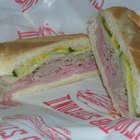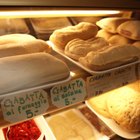
Jupiterimages/Photos.com/Getty Images
A baguette is a long, thin, crusty loaf of bread that has come to symbolize French cuisine. There are many ways to serve up a toasted baguette -- in the bottom of a soup bowl, as a sandwich or panini, as bruschetta, or even chopped or crumbled as croutons or breadcrumbs. Toasting a baguette is very easy and it makes an excellent base for a world of tasty toppings.
Cut the baguette into 1/4-inch slices and place them on a cookie or baking sheet in a single layer.
Brush the baguette slices with butter, margarine or olive oil.
Bake the baguette slices in a 400-degree Fahrenheit oven 8 to 10 minutes or until golden brown. Turn the bread so that it toasts on both sides.
Top the toasted baguette with goodies like: goat cheese and smoked salmon; pecan butter, Brie and applies; or just a swipe of olive oil topped with a dash of salt and pepper.
Related Articles

Things to Make With Ciabatta Bread & ...

How to Make Cuban Sandwiches

How to Cook With Havarti Cheese
What to Serve With a Lasagna Dinner

How to Make a Subway Sandwich

What Is the Best Way to Toast ...

How to Make Tomato Bruschetta

Meals With Garlic Bread

How to Bake Mac & Cheese With a Bread ...

How to Freeze Brioche

How to Prepare Pre Cooked Shrimp

How to Serve Ravioli

How to Cook Pancetta

How to Egg Wash a Loaf of Challah Bread

What Kind of Bread Do You Use to Make a ...

Add Flavor to Foods With This ...

How to Serve Ciabatta Bread

How to Make a Vegemite Sandwich

What Dessert Can I Make With Leftover ...

Cooking Polenta Tube Slices
References
Writer Bio
Mary Strain's first byline appeared in "Scholastic Scope Magazine" in 1978. She has written continually since then and has been a professional editor since 1994. Her work has appeared in "Seventeen Magazine," "The War Cry," "Young Salvationist," "Fireside Companion," "Leaders for Today" and "Creation Illustrated." She earned her Bachelor of Arts in English from Oglethorpe University in Atlanta.
Photo Credits
Jupiterimages/Photos.com/Getty Images